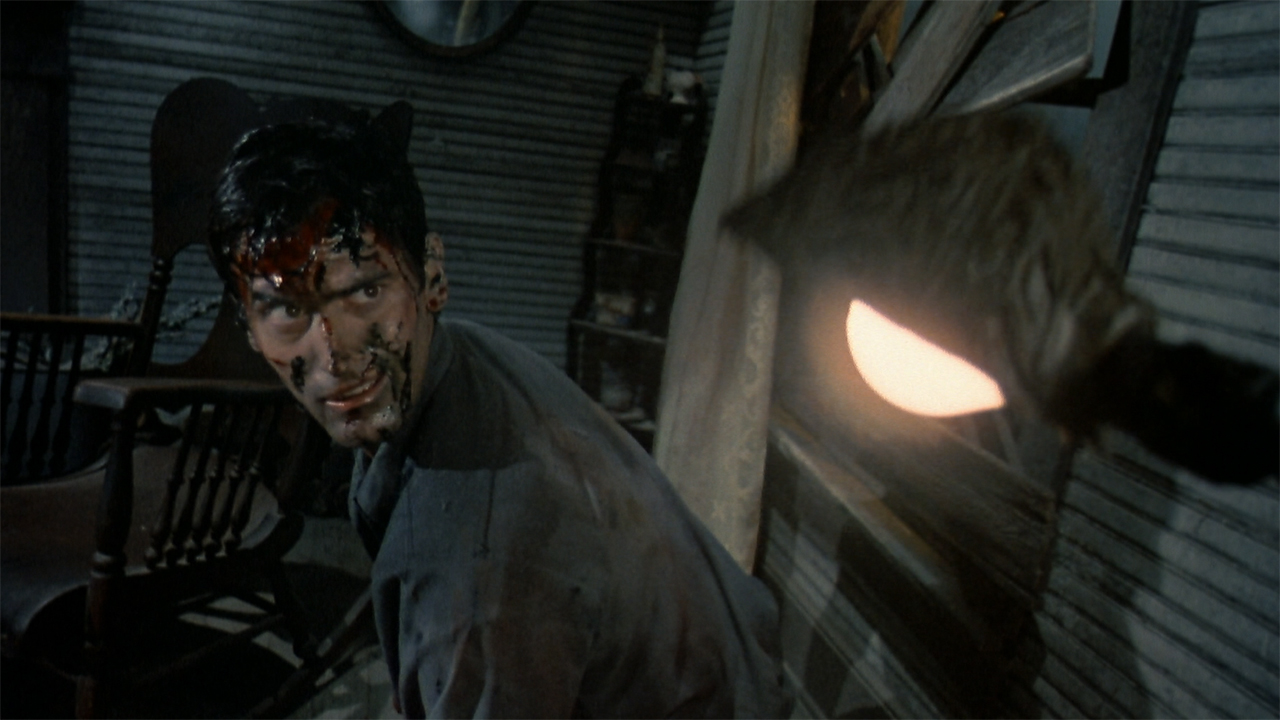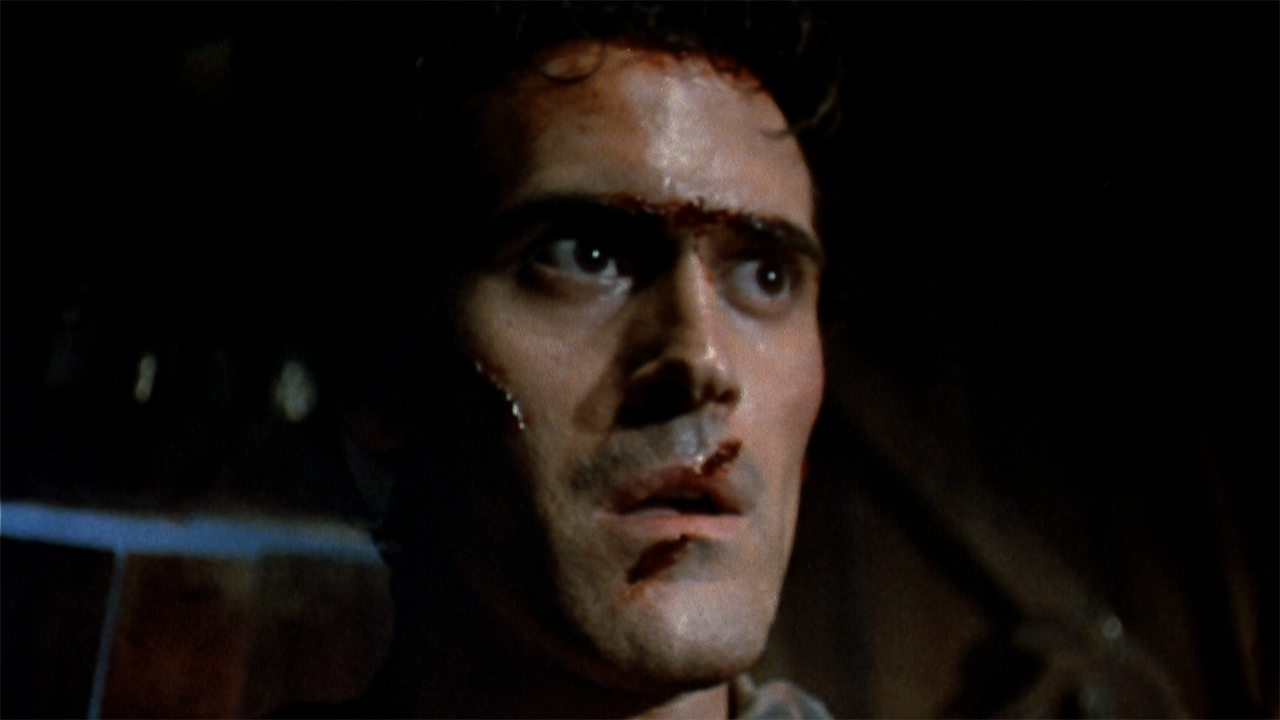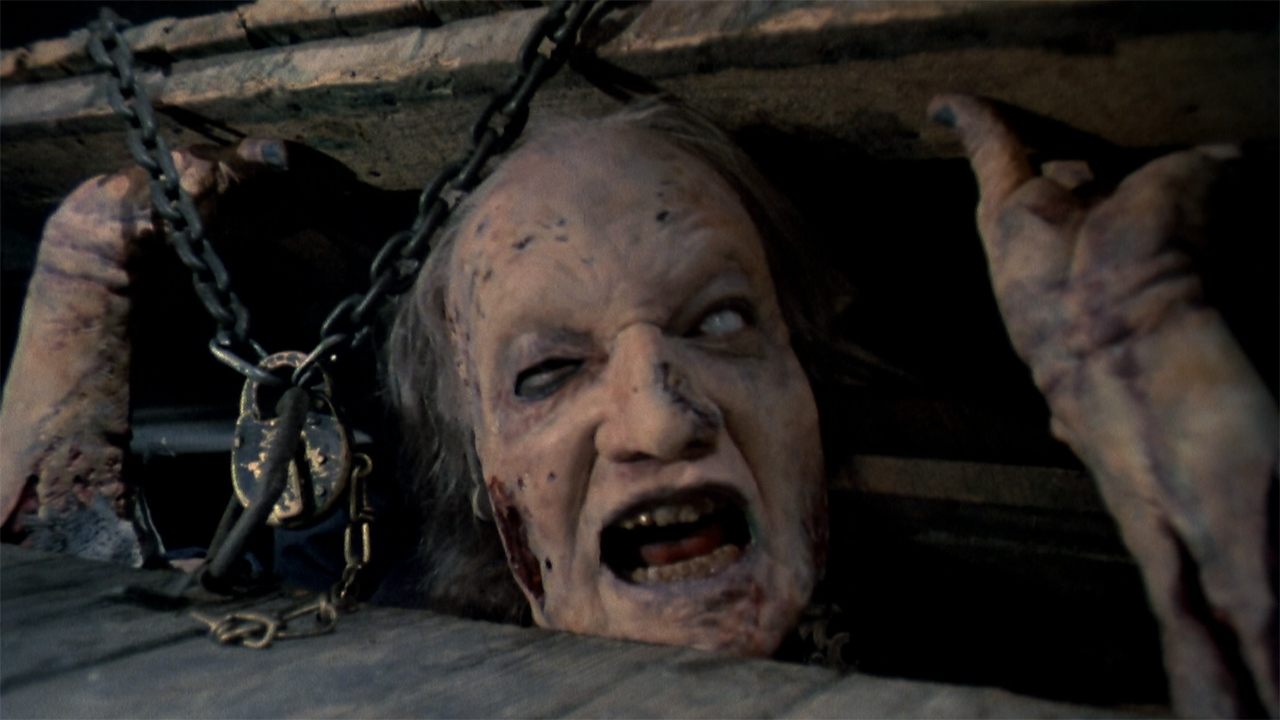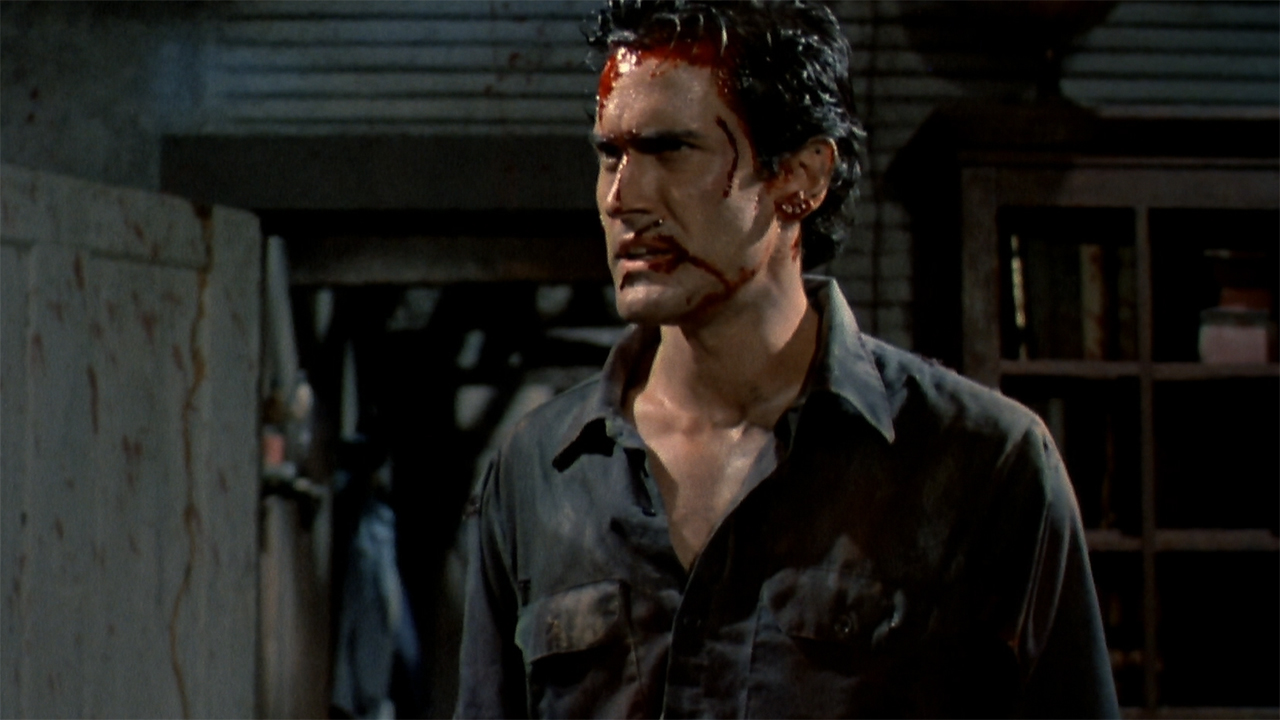Evil Dead's History And Legacy: 1987's Evil Dead II Is A Remake, A Sequel, And One Of The Best Horror Movies Of All Time
An in-depth look at Evil Dead II: one of the greatest horror movies ever made.

Sam Raimi didn’t want to make Evil Dead II. Along with his cohorts Bruce Campbell and Rob Tapert, the director had made an indelible mark on the filmmaking world with the 1982/1983 release of The Evil Dead, and he had aspirations to make a lot of different kinds of movies (which he would subsequently do). Unfortunately, things didn’t work out as planned career-wise for the trio, and a hand was forced.
Teaming up with screenwriters Joel and Ethan Coen, Raimi, Campbell and Tapert made 1985’s Crimewave as their follow-up to The Evil Dead, and it was a disaster. While the movie has found an audience in the decades since, the production was filled with conflict as the filmmakers clashed with studio executives (a rough follow-up to the arduous experience making their feature debut) and it ended up being a box office bomb. As recounted in the documentary Swallowed Souls: The Making Of Evil Dead II, the Michigan-born friends needed to restore their Hollywood reputations in the aftermath, and the clear path to doing so was making an Evil Dead II.
While an initial script draft for the sequel was written by friends Scott Spiegel and Josh Becker with Sam Raimi, Bruce Campbell and Rob Tapert attached to produce, that version was rejected, and eventually Raimi made the decision to get back into the driver’s seat. In addition to directing, he co-wrote a new screenplay with Spiegel, and their shared goofy sensibilities had a significant impact on the work – with Evil Dead II featuring an emphasis on Three Stooges-esque physical comedy to pair with all of the extreme horror.
As far as actually getting the film produced, Stephen King once again had a role to play, having previously supported the original The Evil Dead by writing a piece about it for Twilight Zone Magazine following the movie’s premiere at the 1982 Cannes Film Festival. In the early 1980s, producer Dino De Laurentiis was a major name in producing adaptations of King’s work, and that includes King’s 1986 directorial debut Maximum Overdrive. According to Evil Dead II studio manager David Goodman, it was on the set of that notorious feature that the beloved sequel took major steps towards getting made. Goodman explains in Swallowed Souls,
Stephen King made Evil Dead in a way because he did that interview in Twilight Zone Magazine. He loved it so much he did that glowing piece about it. He’s down in North Carolina doing Maximum Overdrive as a director, right? And there’s a second AD who was on the second unit shoot of Crimewave, and they’re having lunch and Sam [Raimi]’s name gets brought up. And so he goes to Dino [De Laurentiis] and says, ‘You should actually do the sequel to Evil Dead.’
Originally from Italy, Dino De Laurentiis had a particular interest in the potential of international box office during his filmmaking career, and the success that The Evil Dead had outside of North America prior to its domestic debut made a significant impression. According to Bruce Campbell, unproductive conversations about the sequel were had with other studios at the time, but it took all of 15 minutes for a deal to be done with De Laurentiis. Even better, foreign sales arranged by the producer resulted in the film being considered profitable even before the start of production.
Sam Raimi took a lot away from his chaotic experiences making The Evil Dead and Crimewave, and he made specific efforts to avoid issues while working with the cast and crew in Wadesboro, North Carolina – and he was successful for the most part. It wasn’t without some turmoil, however, as described by Bruce Campbell. Though there was a lot of comradery on the set, some members of the production questioned Raimi’s vision for Evil Dead II to the extent that the director eventually needed to fire a number of people and find replacements. The actor/producer recalls,
We had what you would call ‘The Night of the Long Knives’ where we were forced to, because of their uncooperative nature of this whole crew, we fired in the course of a weekend the entire camera crew, grip, and electric department – because they were questioning everything that we did, moving the camera here, lighting here, lighting there. And we’re like, ‘Wait a second, guys. This isn’t normal. We’ll tell you where to do stuff, where to light. Don’t worry about it. It’s not your problem.’ It became just not a good situation and we replaced a third of our crew in the course of a weekend.
According to Campbell, those who stayed on were only more passionate in the aftermath to ensure that the film reached its full potential.
Your Daily Blend of Entertainment News
The filmmakers ultimately had the chance to make the movie that they wanted to make, with Sam Raimi making the crafty decision to have post-production done in Michigan – though that by itself created some complications. Raimi, Bruce Campbell and Rob Tapert were contracted with Dino De Laurentiis to make an R-rated movie given that De Laurentiis Entertainment Group had agreements in place with Motion Picture Association of America, but that’s not a detail to which they ever paid much attention (as was the case in the making of the controversy-stirring The Evil Dead).
It could have created an issue, but the filmmakers found a solution in the form of Rosebud Releasing: a fake distribution company. In Campbell’s words,
We didn’t really want to deal with the ratings people. They didn’t like us, and we thought that showing a film like that to a bunch of people who were part of the PTA just didn’t seem like it was going to work… We found this with Evil Dead: if your movie is unrated, some newspapers will not take the ad; some TV stations will not show your two minute trailer, because they just don’t know what it is. So we had to form Rosebud Releasing… we created a false distribution company for some strange reason to get around all this various stuff.
Evil Dead II didn’t exactly become a box office smash hit, but what it did quickly do was find a passionate cult audience. Thirty-six years later, it is now recognized as one of the greatest, most beloved, and most influential horror movies of all time – and, of course, it’s a key part of Evil Dead’s History And Legacy.

Why Evil Dead II Is The Best Movie The Evil Dead Franchise
Sam Raimi and company took big swings with Evil Dead II. You’d think that pressure to make a hit would have resulted in the filmmakers trying to replicate their previous success by following a formula, but there is nothing about the sequel that is formulaic. While still being horrific, scary, and (literally) overflowing with gore, it embraces ridiculousness in the most phenomenal fashion, and the result is entertainment so blissfully brilliant that it’s dizzying.
As noted in last week’s column, the Evil Dead franchise is difficult to define as a result of the vast differences that exist in each entry, but Evil Dead II is where it’s at its peak and most iconic – from Bruce Campbell’s Ash Williams sporting his sawed-off shotgun and wrist-mounted chainsaw, to the laughing cabin, to the horrors of the Deadites brilliantly crafted by geniuses Greg Nicotero, Robert Kurtzman, Howard Berger, and Mark Shostrom (particularly the monstrous Henrietta, played by Ted Raimi under extreme prosthetics). When people think of Evil Dead, they think of Evil Dead II.
Story-wise, it’s certainly a strange chapter of the franchise due to its relationship with the events that transpire in The Evil Dead (more on that in a bit), but none of the other movies nor the TV show – as great as they all are – hit the tremendous highs of filmmaking skill and fun that are accomplished in the 1987 release.

How Evil Dead II Fits Into The History Of Horror
Released into theaters in March 1987, Evil Dead II came out during a big boom time for the horror genre, with originals like Hellraiser, The Lost Boys Prince Of Darkness and Near Dark hitting theaters along with other franchise sequels like A Nightmare on Elm Street 3: Dream Warriors, Ghoulies II, Silent Night, Deadly Night Part 2, and Howling III.
Where the film was definitely ahead of the curve, however, was in franchise tonal shift. From A Nightmare on Elm Street to Leprechaun to Child’s Play/Chucky, there is a long history of scary movie sequels getting silly… but usually that’s not a move made until the creative well starts to run dry after multiple installments. It can sometimes be the case that a pivot to laughs to match scares is disastrous and can lead to rejection from once die-hard fans – but Evil Dead II isn’t a movie that plays by any rules and executes the move flawlessly.

How Evil Dead II Changes Its Franchise’s Canon And Future
Horror franchises in general are not recognized for having clear and planned continuities, but Evil Dead II nonetheless stands out as an odd sequel. While Sam Raimi, Bruce Campbell and Rob Tapert had the ability to produce the film, what they didn’t have were the rights to include footage in the movie from The Evil Dead. As such, the first act is ostensibly a fast-forwarded remake with major changes made – the most significant being Ash and Linda (Denise Bixler) traveling to the cabin alone instead of with their friends.
Aesthetically, the film further established what would become Sam Raimi’s trademark style, full of odd angles, speeding cameras, and quick punch-ins, but in the context of the franchise, Evil Dead II is notably the first movie in the series to feature a workshop montage with Ash establishing his most famous look.
Of course, as far as this section of this column is concerned, the most significant forward-looking part of Evil Dead II is its final sequence, with Ash being sucked into a time vortex and getting dumped into the middle ages along with his car (Sam Raimi’s 1973 Oldsmobile Delta 88, which has been featured in almost all of the director’s films). It’s a setup for events that transpire in the sequel – though much like how Evil Dead II changes certain details from The Evil Dead, Army Of Darkness changes certain details from Evil Dead II (more on that next week!)

Is Evil Dead II A Good Horror Movie In General?
It would be a lie to say that the comedy in Evil Dead II doesn’t somewhat undercut its scares – but the movie balances that out with exceptional filmmaking craft. Humorous as it may be to see the entire cabin break out with Ash in hysterical laughter, it also brilliantly gets across the feeling of going insane. And as silly as it is to watch a possessed hand smash plates over its owners head, the film still delivers chills as Ash declares, “Who’s laughing now?!” while applying a running chainsaw to his own wrist. And those moments are just icing on the cake when paired with the terror of the Deadites.
Evil Dead II is certainly an evolution from The Evil Dead, but it’s also a brilliant work that wholly stands up independent of the rest of the franchise as an amazing cinematic treat filled with laughs and scares. In a word, it’s groovy.

How To Watch Evil Dead II
If you’re watching/rewatching all of the Evil Dead franchise in anticipation of Evil Dead Rise, and you have already seen The Evil Dead, the good news is that Evil Dead II is exceptionally easy to find. While the movie is not presently in the libraries of any subscription services, it is available to rent and purchase from online outlets including Amazon, Vudu, Apple, and Google Play. The best option that currently exists for physical media collectors is the 4K UHD release from 2018.
As we continue to countdown the weeks until the release of Evil Dead Rise, Evil Dead’s History And Legacy will be back next week with a new feature about 1992’s Army Of Darkness. Look for the column next Thursday here in the CinemaBlend Movies section.

Eric Eisenberg is the Assistant Managing Editor at CinemaBlend. After graduating Boston University and earning a bachelor’s degree in journalism, he took a part-time job as a staff writer for CinemaBlend, and after six months was offered the opportunity to move to Los Angeles and take on a newly created West Coast Editor position. Over a decade later, he's continuing to advance his interests and expertise. In addition to conducting filmmaker interviews and contributing to the news and feature content of the site, Eric also oversees the Movie Reviews section, writes the the weekend box office report (published Sundays), and is the site's resident Stephen King expert. He has two King-related columns.
